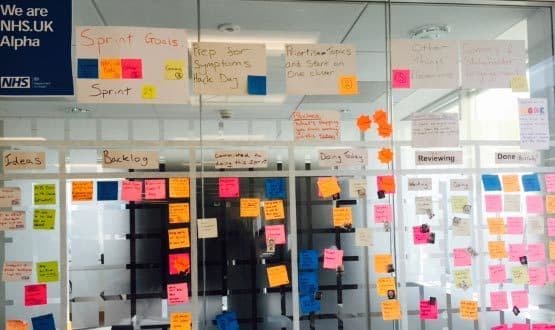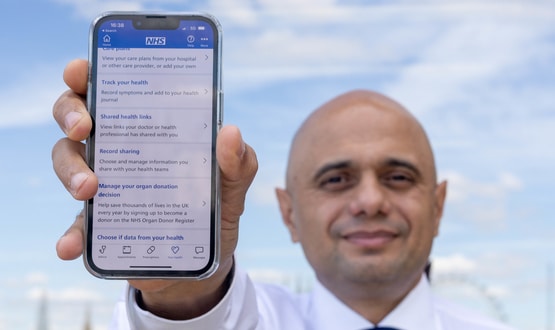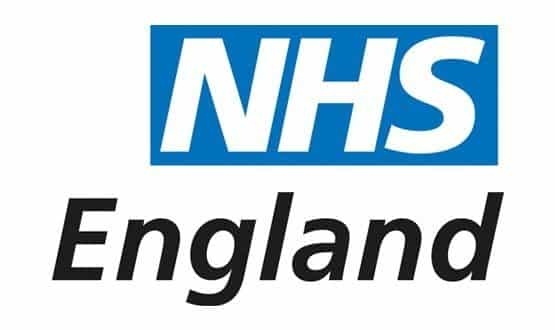NHS Alpha: the team creating a new NHS.uk

As NHS Alpha prepares for a developmental move into the ‘beta’ stage of its project, the team is also preparing for a physical shift into Skipton House at Elephant and Castle.
Currently housed at the NHS’ high-spec offices in Waterloo, strategy lead Dan Sheldon says they “sort-of just moved in” there one day and nobody told them to leave. But the expansion of the small team to around 50-60 people over the next year necessitates a move into more spacious surroundings.
Still tucked away in a corner of Wellington House during Digital Health’s visit, the team congregates for a daily ‘stand-up’ meeting.
Brightly coloured post-it notes are shuffled along a glass kanban board as they move from ‘ideas’ to ‘backlog’, to ‘committed to doing this spring’ to ‘doing today’ to ‘peer reviewing’ to finally end up in the overcrowded ‘done’ pile – ‘hurrah!’
The rainbow collage at the end of the journey reflects the fast-pace agile development style adopted by the Alpha project.
What is NHS Alpha?
NHS Alpha officially kicked off in September last year, but what it is trying to achieve has been talked about for much longer and has come under many titles.
The 2012 ‘Power of Information’ strategy promised “a comprehensive online ‘portal’ – bringing together the best of the relevant information and online services currently provided by existing web services: NHS Choices, NHS Direct online, NHS 111 online content and HealthSpace [the now defunct patient view of the NHS Summary Care Record].”
Other names for this digital transformation project have included the ‘digital front door’, ‘daughter of NHS Choices’, ‘health and social care digital service’ and the even more memorable ‘integrated customer service platform’.
NHS England has now settled on the name NHS.uk to encompass the work being done to encourage patients to interact digitally with the NHS and the Alpha team has been tasked with exploring how best this can be done.
Sheldon says the small a multidisciplinary group of designers, product people and developers as well as clinical, strategy and policy experts, has really picked up the project and run with it. “It allowed us to make so much more progress by working collaboratively,” he says.
“We have made more progress in the past few months than we have in the past few years on this. We are here to improve the NHS; not just build a shiny front end to it.”
The current situation
Sheldon says the main online offering from the NHS at the moment is information; so you can “find out about the NHS online, but typically can’t do things.”
Two key national digital services introduced over recent years have changed this, he says: the Patient Online programme and NHS e-Referral Service. Both of these operate alongside a host of local and GP projects to enable people to find services and undertake some basic transactions.
However, there is nothing stitching it all together. Instead, patients are forced to do that themselves and that’s what NHS Alpha has been thinking about.
On top of this, there is the £30 billion funding gap that could open up in the NHS by 2020, if it fails to deliver on the ‘Five Year Forward View’ plan to deliver efficiency savings through new ways of working.
Channel shift is part of the plan; to use digital services to make sure patients get to the right place for care the first time; and to empower patients to undertake more care themselves.
A tough ask
Joining up all the information and services that the NHS has put online is no small task. There are 30,000 pages on NHS websites.
Sheldon says analysis shows that many will recommend that a patient visits their GP; but often this is the risk adverse answer. He believes there is real opportunity to make the NHS more efficient and reduce pressure on services by joining up online and offline more effectively.
This cannot be done in one foul swoop as there are currently more than 3,000 websites on the NHS.uk domain, so the team has started by looking at particular patient groups and how they might navigate their way around the NHS web.
“We’re not going to do the biggest website migration in history and try to create a single website. This is not about NHS.uk replacing all of those websites. Over time it might become more rationalised, but that’s not our primary task,” Sheldon says.
What comes next
The two conditions the team decided to focus on first are diabetes and depression, as entry points to understanding the needs of users via the experience of real patients.
Rather than just produce a strategy or report or diagrams, they felt it would be more powerful to actually develop things that people can see, so they brought in people to build digital tools early on.
They have done pop-up research in practices and labs with patients, where they can observe and question them, and tested some of their new pages for the first time in March at a local practice.
Altogether they have transcribed more than 100,000 words and from that picked out key learnings, which when mapped out started to reveal some common themes. Sheldon says the agile nature of the Alpha team means they can do research sessions in the morning and change a prototype in time for the afternoon session.
One of key learnings was that people currently find it much easier to call their practice than book an appointment online. It is also difficult for people to navigate the NHS, particularly those with complex needs, as it operates in silos.
There is also a need to change mental perceptions about where people can go for help, to make them think of doing things online first.
And while there are many thousands of pages of information available, this is not necessarily structured in the most effective way. A person who has just been diagnosed with diabetes, for example, may look on the NHS Choices page and the first thing they read is a definition of the disease along with how many people in the UK have it.
Sheldon says that while this information may be interesting to people down the line, for a newly diagnosed patient the only thing that matters is that they have it and they need information about what to do next.
New prototype pages are therefore much simpler, making it easier for patients to get the information they need without scrolling through long chunks of text.
The research also showed information is much more valuable if it is personalised to the user, so a prototype ‘diabetes planner’ shows the person’s latest test results and gives advice specific to their case.
It is also important to bring content and services together, Sheldon says, so the newly designed pages have buttons such as ‘make a GP appointment’ embedded within them.
Of course, all of this functionality relies heavily on some technical work being done to ensure correct identification of the patient and to develop and link the GP systems which will feed through booking and test result information. Also, to have other services to point them towards if necessary.
Sheldon thinks of it as building blocks towards the end goal of a seamless experience for patients.
No ‘big bang’
The Alpha team have so far produced alternative pages for eight long-term conditions and these will be tested with real traffic from NHS Choices, with some people directed to the old site and some to the new site. When they can prove that the new pages are better they will start directing all traffic in that direction.
“It’s not a big bang approach, it’s just slowly getting better over time so it’s not a big surprise for people,” Sheldon explains.
What will happen to the old pages is not yet determined as the team is still looking into the question of at what point people may want to know more about their condition and want the more ‘encyclopedic-type’ content.
Sheldon says the big difference with the new site is that the move from providing information, to providing personalised services and connecting people with real action.
“Over the next year the public will start to see some big changes, none that will surprise or shock them, but it will make things better and will hopefully make the NHS work better for them. We’re not here to build shiny new websites, but here to improve services and make the NHS easier to use and that’s the measure of our success.”




